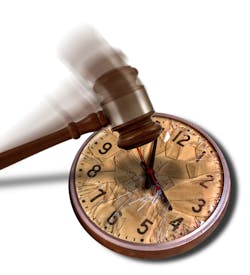Groups cite driver fatigue in HOS suit
Claiming the Federal Motor Carrier Administration (FMCSA) revamp of the truck driver hours-of-service (HOS) rule “fails to address driver fatigue,” the interest groups Advocates for Highway and Auto Safety, Public Citizen and the Truck Safety Coalition as well as two individual truck drivers have filed a lawsuit challenging the new rule.
It is the second suit filed with the U.S. Court of Appeals for the District of Columbia Circuit this month. The previous filing was by the American Trucking Assns. on February 14. ATA spokesperson Sean McNally told Fleet Owner the association “hopes to get a final decision before the new HOS rule goes into effect in July of 2013.” McNally said that ATA is greatly concerned about certain provisions in the final rule —including the 34-hour restart—as well as “actual regulatory analysis that was conducted [by FMCSA] and how that data was approached and used or misused.”
In the newest filing, according to the group of claimants, the “latest federal rule for truck driver hours of service still fails to make needed improvements to protect the public from tired truckers and should be subjected to judicial review.”
“Given FMCSA’s mission to prevent truck-related deaths and injuries, it is appalling that the agency issued yet another rule that fails to adequately address truck driver fatigue and puts the public’s safety at risk,” said Henry Jasny, vice president & general counsel for Advocates for Highway and Auto Safety.
In the joint lawsuit, the parties have stated they are seeking judicial review of the final HOS rule (issued on Dec. 16, 2011, by FMCSA). The claimants contend the agency final rule “failed to reduce the 11-hour limit on consecutive driving hours to 10 hours, despite the agency’s statement in the proposed rule that ‘the 10-hour rule is currently FMCSA’s preferred option’ because it would be most effective in reducing driver fatigue.”
The parties further argue that although the agency had no data to support its adoption of the longer 11-hour limit in 2004, “the agency decided to stand by that mistake even though it comes at the cost of numerous additional fatigue-related crashes.” In addition, they claim the new final rule fails to eliminate the 34-hour restart provision that “encourages cumulative fatigue and allows drivers to exceed weekly driving and work limits.”
The restart provision—which the claimants contend was first instituted in 2004 without any supporting data or research—reduces the off-duty time drivers are allowed from 48 or more hours to just 34 hours after driving up to 70 hours and working more than 80 hours over eight days. According to the parties, changes included in the December 2011 final rule “do not prevent the most fatigued drivers, those who work on a schedule of 70 hours of driving in eight days, from continually using the short and unacceptable 34-hour restart every week, or being required to do so by their trucking company.”
Furthermore, the claimants state that the driver surveys sponsored by the agency show that under the current HOS rule, two-thirds of truck drivers (65%) acknowledge that they drive while tired, and nearly half (48%) admit to falling asleep behind the wheel in the previous year.
And there’s more. Per the parties, adding to the problem of driver fatigue is that the new rule “includes a loophole that allows truck drivers to sit in the cab of their truck during their 10-hour off-duty rest period instead of sleeping. This will only lead to increased rates of driver fatigue among long-haul drivers who do not have sleeper berths in their trucks.”
“Despite the fact that truck crash fatalities increased by nearly nine percent in 2010, and more than 100,000 people were injured, at a cost to society of nearly $42 billion, the FMCSA Administrator has chosen to imperil public safety by keeping unsafe and illegal driving limits for truck drivers,” said Joan Claybrook, Chair of the Board of Citizens for Reliable and Safe Highways (CRASH), which is part of the Truck Safety Coalition.
“Unfortunately, industry pressure trumped public safety,” commented Daphne Izer, founder of Parents Against Tired Truckers (PATT) part of the Truck Safety Coalition. “The research is clear and compelling. However, FMCSA’s decision to keep the longer, more dangerous 11 hours of driving time rather than returning to the 10-hour limit will put the public and truck drivers at risk.”
According to David Heller, director of safety & policy, the Truckload Carriers Assn.’s (TCA) Board of Directors will take up the question of how to respond to the HOS rule at the group’s annual conference next week. He told Fleet Owner that TCA has the “option of filing an amicus brief [in support of the ATA petition] or taking other actions.”
While the advocacy groups and truck drivers filing suit against the HOS rule argue that the 34-hour restart provision “encourages” driver fatigue and “allows drivers to exceed weekly driving and work limits,” Heller said that the trucking industry opposes the 1-5 a.m. consecutive (daily) rest periods that were added to the restart provision.
“Having these mandatory breaks does not mean truck drivers will necessarily rest or sleep during them,” he pointed out. “On the other hand, having these breaks in place would interfere greatly with just-in-time deliveries, which usually involve pickups in that early-morning window.
What’s more, Heller continued, these breaks could add to the driver shortage because they can “sideline” drivers for not part of one but part of two nights in a row. “That will lead to more switching out of drivers.”
As for the party of claimants seeking to cut the 11-hour limit on consecutive driving hours to 10 hours, Heller said the trucking industry is in favor of keeping the 11th hour for operational flexibility “at least until firm science can be found to favor cutting it to 10 hours. That hour is needed especially by long-haul drivers who must find legal parking spaces at the end of their driving shift.”
